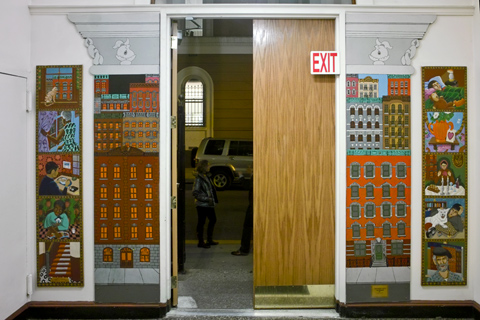
University Settlement, Eldridge Street — © Brian Rose
Saturday evening I went to the University Settlement for a slide presentation, which I thought was going to deal in part with the Lower East Side. It did begin with historic photographs of the neighborhood by important photographers like Jacob Riis and Berenice Abbott, but the contemporary work shown was from other places–four dyspeptic views of the dark side of American society–post Katrina New Orleans, foreclosure misery in Florida and Cleveland, Indian poverty at Pine Ridge, and a fashion show for women in prison. The program included Alan Chin, Brenda Ann Kenneally, Andrew Lichtenstein, and Anthony Suau.
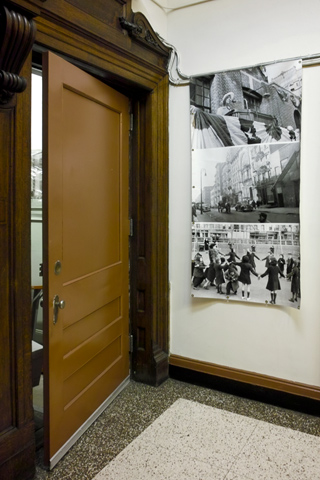
University Settlement — © Brian Rose
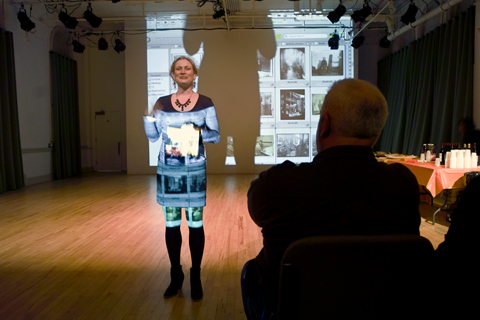
University Settlement slide presentation — © Brian Rose
One of the photographs shown by Anthony Suau depicts a Cleveland sheriff carrying out an eviction. It was the winner of the World Press Photo of the Year in 2008. One website compares this image to the famous Eddie Adams street execution photograph from Vietnam. The assumption is that warfare has come to the streets and homes of America. To me, the photograph is more ambiguous–a police officer stepping through a house strewn with trash, fearful that danger lies beyond the next door. We know it is an eviction, but we know little else of the circumstances. There are different possible scenarios. The larger issue of what led to foreclosures across the United States is the back story, not the immediate one of a fearful step forward by an officer with his gun drawn.
All of the subjects presented by the five photographers are serious, non trivial areas of inquiry, and I was impressed with the skill and commitment of the photographers, but ultimately I have grown so weary of this kind of you-are-there photojournalism that I can barely look at it any more. Surely this is the opposite of the reaction desired. The idea is to expose injustice and shock viewers into action. I am afraid that most people, like myself, tend to look away. The historical Lower East Side pictures were shown as inspiration and motivation for the slides to follow. The biggest difference between the older work and theirs is the difference between showing and telling. Modern photojournalism tends to more openly interpose the photographer between the story and the viewer.
That said, however, I don’t have a new paradigm of photojournalism to offer, and I am aware of the limitations of what I do, which is also a kind of photography that seeks to address social issues, if in a more round about manner. All I can say is that I am, and have been, searching for a way that is more inclusive and acknowledges the complexity of issues and the inherent difficulties in conveying visual meaning.
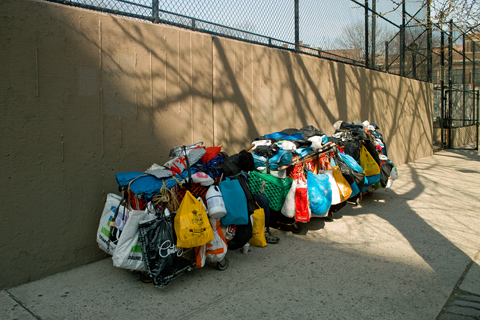
Clarkson Street, the West Village — © Brian Rose
In the photograph above–taken yesterday–there is a person just barely visible in the midst of the shopping carts and bags. What is the meaning or value of this kind of photograph? The sharp sun and shadows, the colorful plastic bags, the crazy incongruity. I do not expect every picture to answer the questions raised, but over the course of my work, I do hope that some threads of meaning become recognizable, some justification emerges, for what is inherently an exploitative enterprise.
Just before going to the University Settlement event I was pleased to meet Kristin Ellington of the multi-media firm Funny Garbage. We talked about the Lower East Side, my photographs, and her interest in creating a website dealing with the neighborhood, history and the present. I am looking forward to seeing her project take shape.
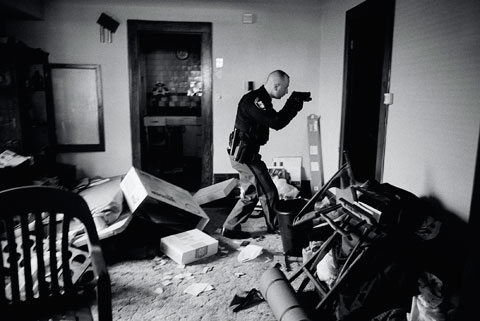
Thank you for your thoughtful and considered response to our presentation.
First I want to say that I am working on a collaborative project with our host that night, the University Settlement, on the contemporary Lower East Side. Hopefully by the autumn we will have results to show.
I would like to address your point of how you feel that many (maybe most) people are weary of traditional photojournalism and don’t want to look at it any more. That may be true for some, but crucially and importantly, I don’t believe it to be true for the communities and people directly impacted. If it is your home, or your neighbor’s, getting foreclosed, for example, you may be very interested in seeing that you aren’t alone, that there are others in your predicament, and that together you can do something about it.
Is this simple, clear-cut, or easy? By no means. And there usually isn’t a direct correlation between journalism and effect in the world. However, in our current age of instant communication and social networking, more than ever I know that we can be effective interlocutors of realities that matter.
Alan Chin
Facing Change: Documenting America (FCDA)
Thanks Alan for your comment. The issues that I am critical of with regard to photojournalism are the same issues I struggle with in my own work, however different. I still believe that photographers perform an important function as witnesses to events, places, and the lives of people. However, I think it behooves all of us to bring a sharply critical approach to a medium that no longer is an unquestioned transmitter of visual reality, if it ever was.
I look forward to seeing your images of the present day Lower East Side–you grew up here–I came here from somewhere else. Please feel free to stay in touch.